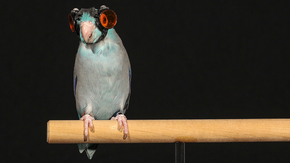
Thanks to Obi-Wan Kenobi, a small parrot with goggles, scientists can confirm how little people know about flying creatures.
Researchers are trying to figure out a problem that has been a difficult but never-tested area of ​​its own: the three most common methods used to calculate how much force a winged or winged animal needs to use to keep their bodies rising. The calculation results are often inconsistent and inaccurate.
In order to conduct research, they spent several months training the parrots to fly up and down from the perches, passing through a flat vertical laser projection plane formed by a cylindrical lens. Does this sound dangerous? Please don't worry, Obi has a custom 3D printing technology goggles as a safety shield, and the laser itself is harmless.
Why use a laser? Because the research team needs to observe a vortex in a three-dimensional manner. This vortex is a miniature air tornado caused by flapping wings when birds fly. The researchers placed 12 high-speed cameras around the 1-meter-long flight path of the parrot in order to record Obi's speed, wake flow and vortex path.
Scientists have recently published their amazing findings in the online edition of the magazine "Biological Inspiration and Bionics": the vortex was disorganized in the blink of an eye, and more precisely, it took about 100 milliseconds. What they observed from the video did not match the results of the three equations.
The result of the two equations always underestimates the takeoff energy. And when the continuous shot clearly shows that the bird is still flapping its wings in the air, another equation still has a zero value that means a free fall. These findings will help researchers develop better flying robots. At the same time, Parrot Obi should be thankful, or should give it an extra bonus: its favorite fresh broccoli. (Zhang Zhang)
WENZHOU DIYE VALVE&FITTINGS CO.,LTD , https://www.diye-valve.com